There are many ways to study inflation. You may start by looking through your collection of bills. Economists like to swear by the consumer price index or indices, if you are even more into inflation. In textbooks like “economics for dummies” we learn about rational behavior and price adjustment mechanisms through the “invisible hand” to find some sort of equilibrium.
Advanced economics courses will teach you about strategic behavior inspired by game theory and the effectiveness/ineffectiveness of cheating. For advanced economists it is, therefore, inevitable that “cheatflation” should be part of the economists’ vocabulary. Of course, a profit maximizing entrepreneur is likely to way the risk of being found out contributing to cheatflation against the potential gains.
How to cheatflate? Too easy. Any producer of a product can cheat by using, for example, other ingredients than those printed on the product label, usually cheaper ones. Instead of fruit juice (wine) you may just sell colored water with lots of sugar (ethanol) in it, but still label it fruit juice (wine) and get away with this, until a consumer protection group makes a fuzz about it. A more sophisticated way is to sell investments in ESG-rated funds, but then include dirty stocks without proper notification in the fund, which probably increases profits based on wrong labels.
There is a specific quality to cheatflation, which makes it different from shrinkflation or enshittification. The drive to “obtain unfair advantages” through cheating across a whole country or region makes cheatflation an economy-wide process and subverts general fairness rules as well as trust in a society.
(Image Saccharometer, DTM Berlin 2024) 
Politician Cycles
In a bookstore which sells books in English or American language we find lots of biographies or autobiographies of politicians. As a politician you don’t even have to be out of politics when your biographical account or your own view is published, let alone be written. Publishers seem to hunt politicians who made headlines, no matter good or bad. Outside the EU you can always sell biographies at half price, if the volumes sit for too long on the precious shelves of bookstores. Most of the biographies are found in the history section of shops or libraries, however some show off in sections like politics (if not dead for too long) or in the business and management sections. Leadership is a big issue in the latter disciplines, but the psychological or sociological literature starts to meddle with the received wisdom of how single person leadership is in fact facilitated with the many great people around the sometimes outstanding single person. Maybe the focus on a single person is an easily understood and simplifying concept of leadership. In the case of Obama (2x) two single historical accounts complement the one person focus. In 2025 Michelle Obama skipped the funeral of Jimmy Carter where she would have had to sit next to Donald Trump (according to the Daily Telegraph and probably endure small talk). Politics appears to move in circles and politicians might find themselves encircled. 
Administration Online
The public administration is more and more moving online. The electronic identity is becoming a reality for all those with a recent personal identity card and who remember where they stored their pin code which came with the card. Moving houses or apartments or car registrations among other official registrations can be carried out online rather than by joining the lengthy queues at your public administration. The “buergerservice.org e.V.” presented the easy steps at the SCCON 2024 in Berlin again to the audiences. The support by the “mobile citizen’s office”, allowed to do the PIN retrieval or change on site and during 2 minutes. This is going to be a game changer for many people who shun away from lengthy admin procedures and push off such registrations due to the time-consuming queueing systems currently in place. Labour shortages are circumvented by e-administration and citizen’s satisfaction with public services increases. More publicity for such e-services and rapid implementation across countries and the EU should bring a about a new e-dynamic drive to old Europe. Employees or civil servants will be pleased to deal with exceptional cases only rather than the bulk of repetitive registrar work. More time will be available to real case management instead of suffering from impatient citizen clients. “Administration as a service” sounds like the new device of digital public management. 
Forest Management
Responsible forest management is key. To safeguard against the loss of biodiversity the management of forests can achieve a great deal as the study in Nature of 2024-4-10 has demonstrated. Reducing hunting by humans in dense tropical forests allows bigger species to survive and thrive compared to forests with easy access by roads. FSC certification of forests helps significantly to protect wildlife. The ability to ameliorate biodiversity of forests is assisted by the Forest Stewardship Council (FSC) through the responsible management, preservation and limitation of access to wild forests. This is an important message that in fact it is still possible to preserve wildlife also of larger species if we only really commit to the cause. It is well worth to support such initiatives and monitor the progress. Of course, any such success attracts new hunters and a continuation of the FSC efforts is needed for the benefit of the whole biodiversity on our planet as there is no planet B.
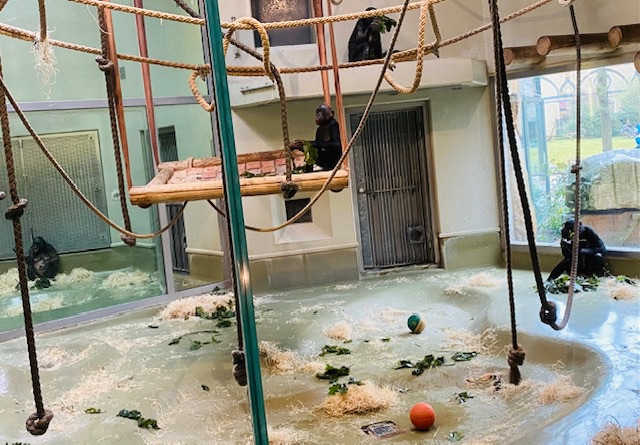
AI and PS
AI like in ChatGPT is guided by so-called prompts. After the entry of “what is AI” the machine returns a definition of itself. If you continue the chat with ChatGPT and enter: “Is it useful for public services” (PS), you receive an opinion of AI on its own usefulness (of course positive) and some examples in which AI in the public services have a good potential to improve the state of affairs. 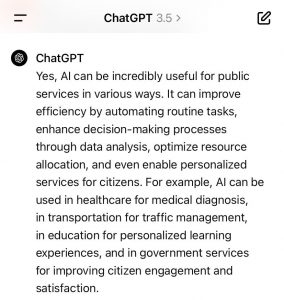 The AI ChatGPT is advocating AI for the PS for mainly 4 reasons: (1) efficiency purposes; (2) personalisation of services; (3) citizen engagement; (4) citizen satisfaction. (See image below). The perspective of employees of the public services is not really part of the answer by ChatGPT. This is a more ambiguous part of the answer and would probably need more space and additional explicit prompts to solicit an explicit answer on the issue. With all the know issues of concern of AI like gender bias or biased data as input, the introduction of AI in public services has to be accompanied by a thorough monitoring process. The legal limits to applications of AI are more severe in public services as the production of official documents is subject to additional security concerns.
The AI ChatGPT is advocating AI for the PS for mainly 4 reasons: (1) efficiency purposes; (2) personalisation of services; (3) citizen engagement; (4) citizen satisfaction. (See image below). The perspective of employees of the public services is not really part of the answer by ChatGPT. This is a more ambiguous part of the answer and would probably need more space and additional explicit prompts to solicit an explicit answer on the issue. With all the know issues of concern of AI like gender bias or biased data as input, the introduction of AI in public services has to be accompanied by a thorough monitoring process. The legal limits to applications of AI are more severe in public services as the production of official documents is subject to additional security concerns.
This does certainly not preclude the use of AI in PS, but it requires more ample and rigorous testing of AI-applications in the PS. Such testing frameworks are still in development even in informatics as the sources of bias a manifold and sometimes tricky to detect even for experts in the field. Prior training with specific data sets (for example of thousands of possible prompts) has to be performed or sets of images for testing adapted to avoid bias. The task is big, but step by step building and testing promise useful results. It remains a challenge to find the right balance between the risks and the potentials of AI in PS.
Clausewitz 3
As the Russian aggression in Ukraine continues it is interesting to re-read Clausewitz again. In his major work on strategy in warfare we rediscover lots of strategies that Putin’s army applies in the war against Ukraine. But equally, the successful defence strategy of Ukraine with a sizable difference in the size of the army, they both let us better understand the theoretical considerations and relevance of Clausewitz until today. For example,the overriding importance of the size of an army in comparison to the opponent was discarded by Clausewitz (p.111-112) already. He refers to the battles at Rossbach and Leuthen in the Seven Years’ War 1756-1763. Frederic the Great won 2 battles despite having armies of half the size or even less at his disposal (Tempelhoff). Training and morale of the armies is an important part of the explanation of a later outcome. In terms of strategy Clausewitz mentions surprise and wit in chapters as well. The next 3 chapters are devoted to (in modern words) distribution and mobility of forces in space and across time including additionally a strategic reserve. The “classical warfare” which Clausewitz transforms into a theory of warfare is followed with horrific resemblance by Putin’s Russia in the 21st century. “War is an instrument of politics” writes Clausewitz 200 years ago (p. 467-8).
The painters or theorists that attempted to go beyond this rationale have had a hard time to convince politicians otherwise. The idea that law and courts will replace the atrocious power play of nations is silenced again for some years, only to come back with more force eventually.
(Image Extract from Nationalgalerie and Digital Collection of Gemäldegalerie 2024-1 by Adolphe Menzel “Ansprache Friedrich des Großen an seine Generale vor der Schlacht bei Leuthen 1757) unvollendet. 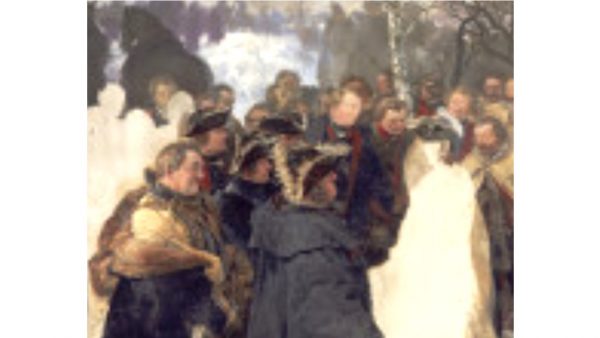
Museum Orga
The cathedrals of modernity are under permanent scrutiny. The discussion in Germany was sparked by a recommendation of the scientific advisory council to the federal government (Wissenschaftsrat) to separate the Prussian heritage museums and institutions (SPK) in Berlin into separate entities that have higher autonomy to shape their individual profiles. Too much hierarchy blocks innovation and openness to new approaches that might not fit an overriding instance of decision making. The arts and sciences as well as their libraries need substantial degrees of freedom to flourish in their specific cultural and societal environment. The same discussion is currently occupying Paris and France, since overall the visitors after the Covid-19 crises have not yet come back to the same levels. Digitalization has opened up new opportunities and potentials to reach new audiences. This needed new resources even at a time of budget constraints. Museums have started to take their social functions more seriously besides their role to preserve the cultural heritage. Economic thinking in terms of scarcity of art works, competition between museums and cities or countries for tourism have entered the stages as well. Prices of entry and quantities of visitors have become additional concerns in the organization of the museum landscape. A lot to cope with and to balance multiple policy targets. Accessibility of those treasures is key. Opening up to broader audiences is costly but crucial to provide the justification of the public funds allocated. Great to see more complementary private investment in this exciting field. The prominent archers in front of the Berlin museums have moved ahead into a new round of competition in the organization of museums.
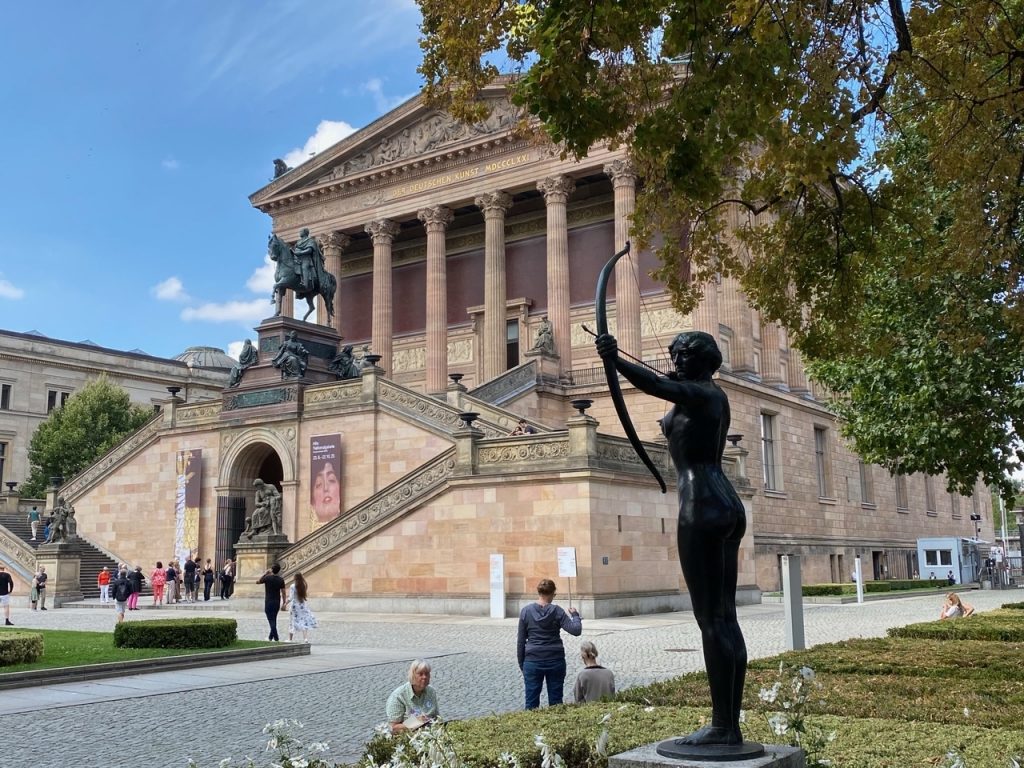
Helplessness
Learned helplessness is another which we have to be aware of as social scientists. It is far from surprising that for example giving birth has been transferred from the professional care and exercise of midwives to medical doctors and hospitals. This creates a kind of maximal security around the most natural of events that of child birth. Over the last few decades we have witnessed a pathologising of birth as high risk event. Additionally an emergencification has pushed costs upwards for social security systems as well. In numerous other domains like breast feeding industrial interests have pushed for replacement solutions which are worse than second best solutions.
In other domains like shopping we tend to believe that we need a car to assist us in the endeavor. It is mostly a choice of the least effort to use a personally owned vehicle to replace other solutions which demand more effort of organization like car or bike sharing options. The frequent result is “learned helplessness”. After years of getting used to the debilitating ease of use of navigation systems in cars and bikes we find it hard to put effort into a little self-organization. Learned helplessness will be a substantial burden on our health and social systems if we do not manage to reverse this trend. At times of increased skill shortages we shall no longer have the many helping hands needed to stem the powerful trend of learned helplessness.

Zauberhaft
Allem Neuen wohnt ein Zauber inne. Das passende Zitat “Und jedem Anfang wohnt ein Zauber inne” von Hermann Hesse ist knapp kommentiert auf Wikipedia zu finden. Diese literarische Einleitung beschreibt recht gut, welche Verzückung bei start-ups zuweilen präsent ist. Nicht nur im Prozess des Gründens, sondern auch in den Kontakten mit Investoren und der ganzen Szene herrscht eine gewisse Extase vor. 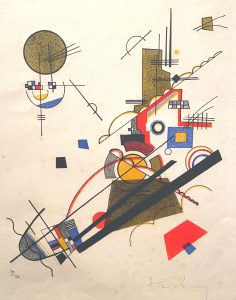 (Illustration W. Kandinsky 1923 Fröhlicher Aufstieg) Gut so, wenn das Start-up zu Beginn bereits eine Qual ist, Hände weg davon. Es wird oft nur schlimmer im weiteren Verlauf und Lebensverlauf. Selbst für enthusiatisch gestartete Unternehmende kommt allzu oft eine Ernüchterung, vielleicht sogar Sackgassen. Einen knappen Überblick bietet die Webseite “Deutsche Startups” oder “startbase“. Die großen Pleiten à la WIRECARD etc. lassen wir mal beiseite. Das kommentieren die Skandalmedien ausreichend, weil Quotenbringer. Mir geht es um die vielen kleinen zauberhaften Anfänge und persönlichen Lernkurven der Beteiligten. Julian Leitloff & Caspar Schlenk (Keinhorn) haben in ihrem Büchlein ein recht schonungsloses Bild gezeichnet, was es wirklich heisst, ein Start-up zu gründen. Vor allem braucht es ein dickes Fell und einen fast unbeugsamen Willen ständig “offen sein für Neues” und Lernbereitschaft.
(Illustration W. Kandinsky 1923 Fröhlicher Aufstieg) Gut so, wenn das Start-up zu Beginn bereits eine Qual ist, Hände weg davon. Es wird oft nur schlimmer im weiteren Verlauf und Lebensverlauf. Selbst für enthusiatisch gestartete Unternehmende kommt allzu oft eine Ernüchterung, vielleicht sogar Sackgassen. Einen knappen Überblick bietet die Webseite “Deutsche Startups” oder “startbase“. Die großen Pleiten à la WIRECARD etc. lassen wir mal beiseite. Das kommentieren die Skandalmedien ausreichend, weil Quotenbringer. Mir geht es um die vielen kleinen zauberhaften Anfänge und persönlichen Lernkurven der Beteiligten. Julian Leitloff & Caspar Schlenk (Keinhorn) haben in ihrem Büchlein ein recht schonungsloses Bild gezeichnet, was es wirklich heisst, ein Start-up zu gründen. Vor allem braucht es ein dickes Fell und einen fast unbeugsamen Willen ständig “offen sein für Neues” und Lernbereitschaft.
Neben den biografischen Details der Gründenden bietet das eckige Büchlein aber auch einen Ausblick auf das Kompetenzspektrum für “Start-ups” und dann später hoffentlich “Grown-ups”. Verstreut über das Buch lassen sich Kompetenzen identifizieren: Buisiness Plan, Erstellen und Überarbeiten, Design Thinking, 3-D Druck, Buchhaltung, Marketing, Personal/Talent Management, Webpage Design und Interaktion über Social Media, Responsibility sowie Finanzen und Investmentkalkulus. Natürlich findet das alles im Team und dann im HomeOffice oder der Garage/Keller statt. Ist ne ganz schöne Packung und bitte nicht die “Deadlines” verpassen.
Das alles liest sich in dem Büchlein unterhaltsam und ohne Pathos der einen oder anderen Art. Aufgrund meiner soziologischen Forschungtradition war mir der Einstieg über das “Phänomen … Survivorship-Bias” (S.9) bedeutsam. Der Überlebendenbias besagt, dass wir meistens nur die Geschichten der Überlebenden (der Titanic) kennen, aber nicht die Geschichten der vielen hundert Ertrunkenen. Eine solche wird in dem Büchlein von den Gründenden erzählt, aber mit einem anderen Happy-End. Einmal Schiffbruch, hoffentlich kein Problem, Aufstehen und ein traumhaftes neues Schiff bauen ist das, was später einmal zählt.
Auszug  aus dem Buch von Julian Leitloff & Caspar Schlenk (Keinhorn) S.12.
aus dem Buch von Julian Leitloff & Caspar Schlenk (Keinhorn) S.12.

